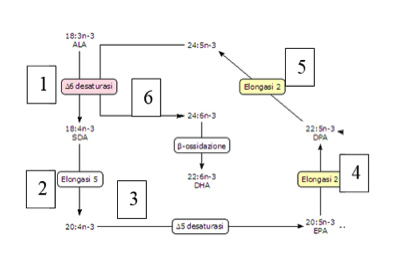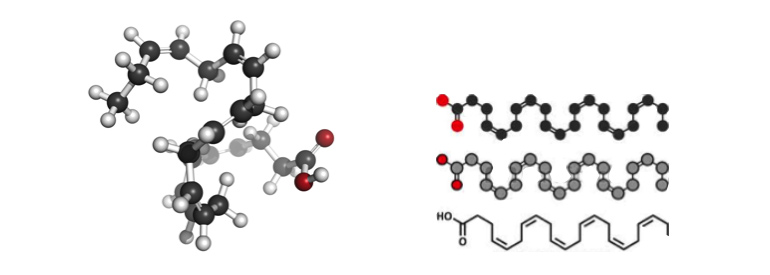
Omega-3 DHA: when fats become our best health allies

The importance of fats in our body
In these first twenty years of the 21st century, fats have finally taken a revenge on all the other molecules that represent our body and diet, because their indispensability for the body health has been recognized. We cannot life and well function without fats and this culture concept must be spread as much as possible to avoid important errors which can therefore cause damage, even serious ones. (C. Ferreri. Dalla Parte dei grassi, Mind Editions, 2019)
DHA: indispensable fatty acid
https://www.pathway27.eu/topstory/docosahexaenoic-acid/
At the top of the list of essential fats is certainly DHA or, as it is correctly defined, DOCOSAHEXAENOIC acid, the molecule shown in the figure and made up of 22 carbon atoms with six double bonds. Since 2010, the European food safety agency EFSA has established the quantity to be taken every day for each individual, which is 200-250 mg, underlining its importance in pregnancy, breastfeeding and in some stages of life, such as during growth (EFSA Journal 2010 8 (3): 1461). In 2014 (EFSA Journal 2014; 12 (10): 3840) the effect of DHA on “normal brain development” was verified, especially for infants and children under 2 years with dosages of 100 mg / day and with dosages 250 mg / day for growth from 2 to 18 years.
Together with the other omega-3 EPA, in dosages of at least 250 mg, DHA contributes to maintaining correct heart function (EU regulation 432/2012).
These quantities can certainly be obtained from a diet that includes sources of DHA, such as algae, or fish that eat algae. In 100 grams of fish 500 mg of omega-3 (EPA and DHA) can be found, therefore it is really necessary to frequently consume this type of food, to maintain the levels of fats essential to health.
The formation of DHA in the body and food sources
Can DHA also be prepared by the body? The answer is YES but, being an omega-3 family fatty acid, its precursor – alpha-linolenic acid ALA – must be assumed which our body cannot prepare (ESSENTIAL FATTY ACID) and therefore must be introduced with food. In short, if you do not eat food with DHA you will have to eat food with ALA!
But which foods? ALA is present in good quantities in linseed oil and flax seeds (which must be shredded), in some vegetables (spinach), but very little in meat, beef or chicken, and in derivatives of these animals (milk, eggs, etc.). The reason for the scarcity of omega-3 sources is also found in the feeding followed in “intensive” farms for the placing on the market of terrestrial and marine animals. Fortunately, we are witnessing a greater awareness of livestock breeders for animal nutrition in more recent times, and consumers can play a very important role in changing the market for the better, if they mainly choose to buy products deriving from farms with food and natural treatments.
How to know the level of DHA in the body
If DHA is not taken directly from fish or algae, its preparation – as mentioned above – can take place by the body starting from ALA and involves 6 enzymatic steps (see figure).
 The enzymes involved in the transformation of ALA to DHA must be efficient, but this is not always the case: in cases of higher consumption of omega-6 fats, or in the absence of certain vitamins or minerals, these enzymes are not able to complete the 6 steps. Thus DHA decreases gradually in the body, and the tissues in which it is indispensable begin to not receive sufficient DHA for their functioning.
The enzymes involved in the transformation of ALA to DHA must be efficient, but this is not always the case: in cases of higher consumption of omega-6 fats, or in the absence of certain vitamins or minerals, these enzymes are not able to complete the 6 steps. Thus DHA decreases gradually in the body, and the tissues in which it is indispensable begin to not receive sufficient DHA for their functioning.
This can happen in the case of absence of fish intake, and therefore if we rely only on ALA to reach the necessary quantities of DHA. This is the case for vegan diets – especially those in which algae are not used.
In this case, it becomes necessary to know the level of DHA reached in your body.
How? In active prevention, you can go to specialized pharmacies and ask to perform the lipidomic analysis of erythrocyte membrane fatpharmacy®, which Lipinutragen has developed with a robotic equipment unique in the world, ensuring precision and reliability.
Given the tissues where DHA plays a fundamental role (brain, heart), DHA levels cannot drop. The optimal percentage present in the membrane of the mature red blood cell (5-7%) is known and, if through the fatpharmacy® analysis, the DHA level is close to or even below 5%, it is necessary to intervene with the feeding, primarily , or with DHA supplementation of at least 200-250 mg per day.
DHA supplements: how to choose them?
Precisely for the integration of DHA and the choice of quality of the supplements on the market, the following points for the consumer are underlined:
1- DHA is a molecule very sensitive to oxidation, therefore the DHA supplement must also contain a well-designed “shield” for the protection of this precious molecule. For example: vitamin E, vitamin C and astaxanthin are an ideal triad for protection in all body areas (aqueous and lipidic).
2- DHA administered as triglyceride from fish oil must be transformed into phospholipid in the body, because in this form it enters the cell membrane, as a constituent of the tissues. DHA-based triglycerides must therefore also be accompanied by “facilitators” of their metabolism, such as the alpha-glyceryl phosphorylcholine molecule, which is the indispensable “brick” for the preparation of phospholipids;
3- Finally, the DHA supplement must not contain other unwanted fats, such as saturated fats and trans fats, because the beneficial effect of DHA refers to a pure source of this fatty acid, and not mixed with other fats that interfere in the its metabolism, distribution and effect.
While DHA in the diet is digested together with all the other active components of the food, DHA in the integration must be in the right formulation to be able to reach the cell membrane from where it exerts its indispensable action. Therefore the formulation must ensure that the dose administered orally is absorbed, protected during biodistribution and incorporated into the phospholipids of biological membranes, as occurs with soft-gel capsules. If you need to check the levels reached by the administrations, you can perform the fatpharmacy® analysis, after a few months of intaking.
Integrating DHA in childhood
We want to conclude with the observation that DHA deficiencies (below 5%) have been found in children suffering from behavioral disorders (our works published on PlosONE 2013 PLoS ONE 8 (6): e66418 and Scientific Reports of Nature 2017, 7, art.no 9854). Although this deficiency cannot be indicated as the sole cause of these disorders, the decrease in DHA must alert the doctor to the possibility of an “essential fatty acid deficiency” disease (EFA deficiency). At this point, having ascertained the deficit, fragile children must take action to ensure the intake of this element so necessary for neuronal development. For this purpose, a nutritional plan is created with the frequent use of the above foods. However, if you cannot ensure the indispensable levels of DHA (250 mg per day), you can resort to integration by ensuring the quality of the chosen supplement, as explained above.
The best supplement for children is that in liquid form and in particular a microemulsion formulation, specifically designed with the above characteristics, is about to enter the market, for the safety of reaching the active site of DHA, the cell membrane.
Dott.ssa Carla Ferreri – Senior Researcher at ISOF-CNR and Lipinutragen co-founder
Photo: 123RF Archivio Fotografico: 28422874 @pichetw /123rf.com | www.pathway27.eu/topstory/docosahexaenoic-acid/
- On 13 February 2020




